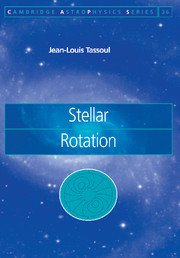5 - Solar rotation
Published online by Cambridge University Press: 15 August 2009
Summary
Introduction
Until recently, only surface measurements of the solar rotation rate were available. Since the mid-1980s, with the advent of helioseismology, much has been learned about the internal rotation of the Sun through the inversion of p-mode frequency splittings. As was noted in Section 1.2.2, it now appears that the observed surface pattern of differential rotation with latitude prevails throughout most of the solar convection zone, with equatorial regions moving faster than higher latitudes. In contrast, the underlying radiative core appears to rotate nearly uniformly down to r ≈ 0.1−0.2R⊙, at a rate that is intermediate between the polar and equatorial rates of the photosphere. Within the central region r ≲ 0.2R⊙, some measurements suggest that the angular velocity increases with depth, implying rotation at a rate between 2 and 4 times that of the surface; other measurements strongly suggest, however, that the solar inner core rotates rigidly down to the center.
The problem presented by the observed solar differential rotation is one of long standing and many efforts have been made to formulate a plausible flow pattern that reproduces the large-scale motions in the solar atmosphere. Following Lebedinski's (1941) pioneering work, many theories have been proposed to explain how the equatorial acceleration originated and is maintained in the solar convection zone.
- Type
- Chapter
- Information
- Stellar Rotation , pp. 138 - 161Publisher: Cambridge University PressPrint publication year: 2000



